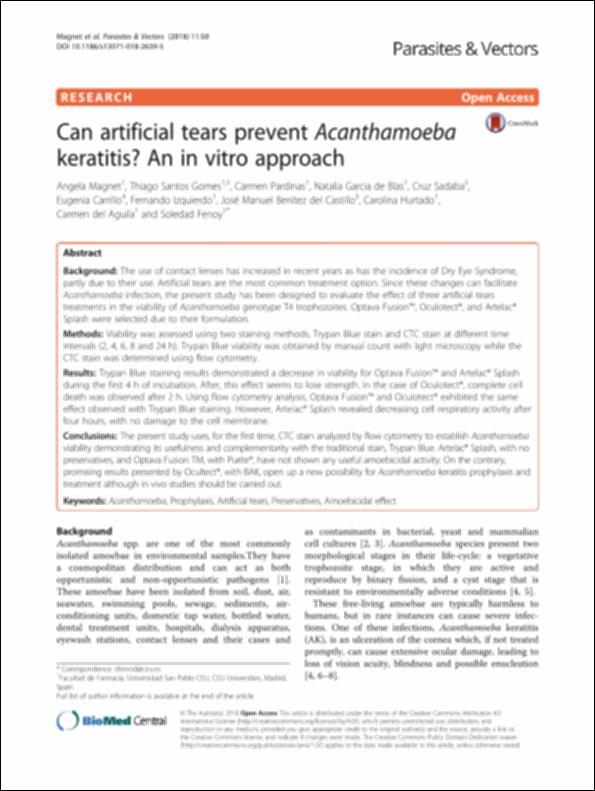Por favor, use este identificador para citar o enlazar este ítem:
http://hdl.handle.net/10637/15065Can artificial tears prevent Acanthamoeba keratitis? An in vitro approach.
| Título : | Can artificial tears prevent Acanthamoeba keratitis? An in vitro approach. |
| Autor : | Magnet, Angela Gomes, Thiago Santos Pardinas, Carmen García de Blas, Natalia Sádaba Argaiz, María Cruz Carrillo, Eugenia Izquierdo Arias, Fernando Benítez del Castillo, José Manuel Hurtado Marcos, Carolina Águila de la Puente, Carmen del Fenoy Rodríguez, Soledad |
| Materias: | Acanthamoeba; Prophylaxis; Artificial tears; Preservatives; Amoebicidal effect |
| Editorial : | BMC |
| Citación : | Magnet A, Gomes TS, Pardinas C, Garcia de Blas N, Sadaba C, Carrillo E, Izquierdo F, Del Castillo JMB, Hurtado C, Del Aguila C, Fenoy S. Can artificial tears prevent Acanthamoeba keratitis? An in vitro approach. Parasit Vectors. 2018 Jan 22;11(1):50. doi: 10.1186/s13071-018-2639-5. PMID: 29357901; PMCID: PMC5778793 |
| Resumen : | Background: The use of contact lenses has increased in recent years as has the incidence of Dry Eye Syndrome, partly due to their use. Artificial tears are the most common treatment option. Since these changes can facilitate Acanthamoeba infection, the present study has been designed to evaluate the effect of three artificial tears treatments in the viability of Acanthamoeba genotype T4 trophozoites. Optava Fusion™, Oculotect®, and Artelac® Splash were selected due to their formulation. Methods: Viability was assessed using two staining methods, Trypan Blue stain and CTC stain at different time intervals (2, 4, 6, 8 and 24 h). Trypan Blue viability was obtained by manual count with light microscopy while the CTC stain was determined using flow cytometry. Results: Trypan Blue staining results demonstrated a decrease in viability for Optava Fusion™ and Artelac® Splash during the first 4 h of incubation. After, this effect seems to lose strength. In the case of Oculotect®, complete cell death was observed after 2 h. Using flow cytometry analysis, Optava Fusion™ and Oculotect® exhibited the same effect observed with Trypan Blue staining. However, Artelac® Splash revealed decreasing cell respiratory activity after four hours, with no damage to the cell membrane. Conclusions: The present study uses, for the first time, CTC stain analyzed by flow cytometry to establish Acanthamoeba viability demonstrating its usefulness and complementarity with the traditional stain, Trypan Blue. Artelac® Splash, with no preservatives, and Optava Fusion TM, with Purite®, have not shown any useful amoebicidal activity. On the contrary, promising results presented by Ocultect®, with BAK, open up a new possibility for Acanthamoeba keratitis prophylaxis and treatment although in vivo studies should be carried out. |
| URI : | http://hdl.handle.net/10637/15065 |
| Derechos: | http://creativecommons.org/licenses/by-nc-nd/4.0/deed.es OpenAccess |
| ISSN : | 1756-3305 |
| Fecha de publicación : | 22-ene-2018 |
| Centro : | Universidad San Pablo-CEU |
| Aparece en las colecciones: | Facultad de Farmacia |
Los ítems de DSpace están protegidos por copyright, con todos los derechos reservados, a menos que se indique lo contrario.


